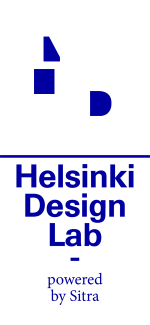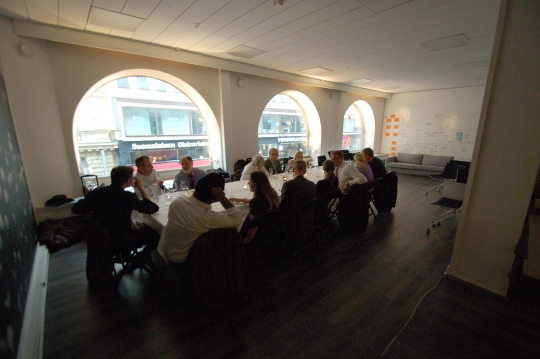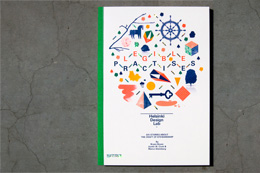Posts tagged with "How-To" contain reflections on designing, organizing, and operating the HDL Studios, a series of three collaborative, multi-disciplinary problem solving experiments we held this summer. These posts are meant to be informative for others who may also be exploring ways to put the design process to use in new ways or those who find themselves struggling to work between disciplines or silos.
—
The best way to share ideas depends on the specific ideas and the audience you want to share with. In other words, the mechanisms of knowledge transfer are every bit as much a design project as is the development of whatever knowledge one aspires to share. This post is about some of the techniques we're using to share our work right now.
In the past, printed reports have been one of the dominant tools for sharing new information, be it research, analysis, or evaluation. For a number of reasons, these reports seem almost mandatory—or may even be legally mandated, depending on your organization's status. But what good is a report that no one reads? And how useful is a report that takes so long to produce it's out of date before the ink dries?
At this early stage in the work of Helsinki Design Lab we've taken a different path, which is to focus on conversations rather than reports. The printed (and online) documentation will come—we're beginning to work on them now—but at this stage the emphasis is on bringing people together with enough time, space, and quality input to have a good conversation.
Review
The model we used in the HDL Studios is based on the "final review" concept which is borrowed from design education. In design school, a studio is comprised of 10-15 students working on their own individual response to a project assignment which is issued at the beginning of the semester. There are interim "pin ups" every couple weeks where the whole studio gathers around to look at in-progress work literally pined up on the wall, while the professor critiques, or "crits" for short, the students' projects in terms of what's working and what's not. The culmination of the design school semester is a "final review" where students present their projects to a panel of 4-6 professors who offer a more substantial critique of the work. This discussion is where the ideas of the semester are teased out, compared, and tested.
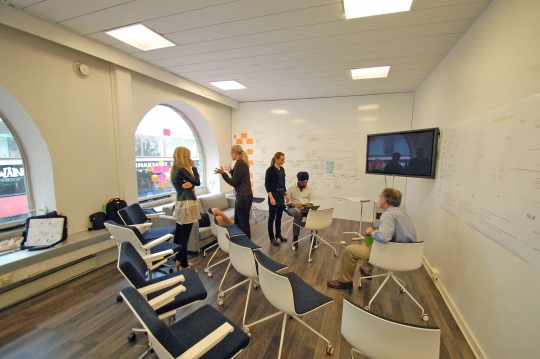
Finishing up slides just before the final review
An HDL Studio works collaboratively on a single holistic proposal and then shares its findings in a final review similar to that discussed above. Months before the studio started we were working to secure a group of 3-5 high level guests from Finland and Brussels who have a vested interest in the theme of the studio. Having the right audience who is both committed to the topic and acutely aware of the nature of the challenge is very important because it makes them good critics, and ultimately good champions.
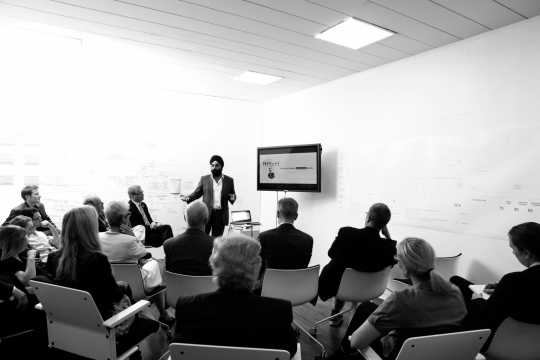
Indy Johar presents the HDL Studio on Ageing's findings. Photo: Ivo Corda
The studio gives a presentation of 30 minute or less sharing how they define the challenge, what opportunities they see, what barriers they perceive, and then outlines a collection of specific project ideas that coalesce into a "roadmap" towards strategic improvement. This is the synthesized outcome of their week in Finland and it may be accompanied by slides, videos, whiteboard drawings, handouts, or any other medium they see fit to use.
After the presentation concludes, we transition into a conversation. This is a moment where the specific nature of the physical space is very important. For these final reviews we pushed the main work table out of the way so that there's nothing between the person presenting and the audience. Once the formal presentation is over, the presenter can sit down and a conversation among peers flows easily. Would there have been a pedestal, table, or other barrier in between the interaction would be too rigid. Making these transitions seamless is important because they are the points where momentum can easily be lost.

As simple as it sounds, having the chairs in a circle really does yield a more active conversation
The worst thing after a presentation is to leave too little time for conversation, condemning what dialog does happen to be mere platitudes and clarifications. Since the two-way exchange of ideas during conversation is our focus in these review sessions, we leave ample time to discuss. In the case of the HDL Studios this summer we had 60-90 minutes of conversation after the review, which is just about enough to process some of the new knowledge which has been shared by the team.
Dinner
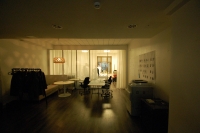
The research office doubled as a field kitchen for the catering staff
After a good stretch of discussion about the presentation, we transitioned again from the review to dinner. Since the studio table had been pushed out of the way, the catering staff could set the table for dinner while things were wrapping up. Having dinner in the studio space with the studio, our guests, and HDL/Sitra team members allows the ideas of the week to settle in through a different, more casual mood. It's both a celebration of an incredible week of effort and a real working dinner wherein the review conversation is revisited and continued. Perhaps most importantly, moving from the review to dinner allows us to spend more time together stewing on the ideas without resorting to an awkwardly long meeting.
By the time everyone leaves on Friday night, there will have been a good four to five hours of intense conversation around the recommendations of the studio team. Especially when dealing with strategic questions that are often complicated and messy, having a solid bit of time to properly talk through things is important. The danger of a short conversation without enough opportunity for back and forth is that the participants use the same words without ever sharing a common understanding. It's a fact that understanding takes time, and that's what the review/dinner pairing is designed to deliver.
Next Steps
We'll address next steps more specifically in an upcoming post, but while we're on the topic of the Friday knowledge transfer it makes sense to discuss a bit of the practicalities of how the conversation moves forward. If the review and dinner are about developing a sense of shared commitment and understanding, next steps arise out of shared opportunities. To help narrow down and specify the nature of those opportunities, HDL will continue the conversation with our stakeholders in Finland over the coming months. To aid this longer phase of discussion, the review and ensuing "critique" were recorded and documented in a summary pamphlet by the studio assistants. We designed the review/dinner from the point of view of what would make that experience as effective of a knowledge transfer environment as possible and then added into the mix a documentary capacity which can add longevity.
Sample schedule
- Months before review: identify and confirm guests
- Weeks before review: set up dinner and other logistics
- Friday 10:00: presentation "dry run" with Studio team and HDL to test the story and work out the bugs
- 15:00: move studio table and arrange chairs for review
- 15:45 guests arrive
- 16:00 presentation starts
- 16:30 presentation concludes and conversation begins
- 17:45 conversation slows down as people get hungry
- 17:50 a short toast before sitting down to dinner
- 18:00 dinner begins and the conversation continues, lasting as long as the table likes
